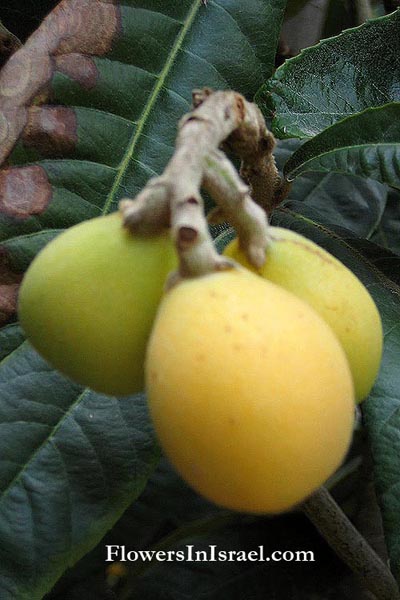Loquat, Medlar tree,
Hebrew: אסקדיניה ,שסק, Arabic: ,أسكدنيا
| Scientific name: | Eriobotrya japonica (Thunb.) Lindl. | |
| Synonym name: | Mespilus japonica Thunb., Photina japonica (Thunb.)Franch.&Sav. | |
| Common name: | Loquat, Medlar tree | |
| Hebrew name: | שסק, אסקדיניה | |
| Arabic name: | أسكدنيا | |
| Plant Family: | Rosaceae, ורדיים |

|
| Life form: | Evergreen large shrub or small tree | |
| Stems: | Ultimate height of 6m; white hairs on young stems | |
| Leaves: | Alternate, entire, serrated | |
| Inflorescence: | Terminal,7cm long, stiff golden yellow panicle | |
| Flowers: | 5 petal white flowers | |
| Fruits: | yellow, orange, sometimes red-blushed fruits, growing in clusters; each fruit contains five ovules, of which one to five mature into large brown seeds | |
| Flowering Period: | Autumn | |
| Origin: | China |

Derivation of the botanical name: Eriobotrya, erion, εριον, wool; botrys, a cluster of grapes; from the woolly, clustered panicles of this Evergreen large shrub or small tree. japonica, Japanese. Mespilus, Medlar. The Latin name for this fruit. Photina, Greek, photizo, to illuminate, from the shiny, reflective leaves of some members of the genus. Loquat, Via Cantonese lou gwat. The Hebrew name: שסק, Shesek, Aramaic: שסקא Sheska; known in foreign languages as אסקידיניה, Eskidinia.
The loquat is allowed to mature fully on the tree. They bruise quite easily and do not keep well out of the fridge. The fruit is pleasant when frosted or rotten and goes well with wine. |